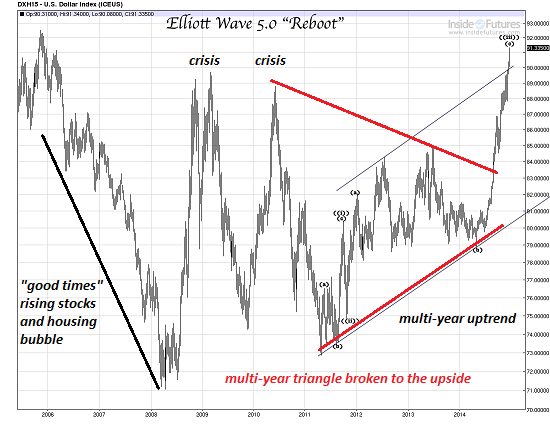Why the Bear of 2015 Is Different from the Bear of 2008
It’s tempting to see similarities in last week’s global stock market mini-crash and the monumental meltdown that almost took down the Global Financial System in 2008-2009. The dizzying drop invites comparison to the last Bear Market that took the S&P 500 from 1,565 in October 2007 to 667 on March 9, 2009.
But this Bear is beginning in circumstances quite different from 2007-08. Let’s list a few of the differences:
1. Then: Markets and central banks feared inflation, as WTIC oil had hit $133 per barrel in the summer of 2008.
Now: As oil tests the $40/barrel level, markets and central banks fear deflation.
2. Then: China had a relatively modest $7 trillion in total debt, considerably less than 100% of GDP.
now: China’s debt has quadrupled from $7 trillion in 2007 to $28 trillion as of mid-2014, an astonishing 282% of gross domestic product (GDP)
3. Then: Central banks had a full toolbox of unprecedented monetary surprises to unleash on the market: TARP, TARF, BARF (OK, that one is made up) rescue packages and credit guarantees, quantitative easing (QE), zero interest rate policy (ZIRP) and direct purchases of mortgages, to name just the top few.
Now: The central bank toolbox is empty: every tool has already been deployed on an unprecedented scale. Every potential new program is simply a retread of QE, yield curve bending, asset purchases, etc.–the same old bag of tricks.
4. Then: Central banks had a relatively clean slate to work with. Interventions in the market and economy were limited to suppressing interest rates in the post-dot-com meltdown era.
Now: Central banks have never stopped intervening since 2008. The market is in effect a reflection of 6+ years of unprecedented central bank interventions. Rather than a clean slate, central banks face a global marketplace that is dominated by incentives to speculate with leveraged/borrowed money established by 6 years of central bank policies.
5. Then: Interest rates had rebounded from the post-dot-com lows in 2003. The Fed Funds rate in 2006-07 was above 5%, and the Prime Lending Rate exceeded 8%.
Now: The Fed Funds Rate has been screwed down to .25% for 6+ years–an unprecedented period of near-zero interest rates.
6. Then: The average 30-year mortgage rate was above 6% from October 2005 to November 2008.
Now: Mortgage rates have been under 4% in 2015.
7. Then: The U.S. dollar only soared in financial crises as capital flowed to safe havens in late 2008-early 2009 and again in 2010.
Now: The U.S. dollar began a 20% increase in mid-2014, in the midst of what was generally perceived as a solid global expansion.

8. Then: The U.S. dollar fell sharply from 2006 to 2008, and again in 2010 to 2011, boosting the overseas profits of U.S. corporations that account for 40% to 50% of total multinational corporate profits.
Now: The rising dollar has crushed the overseas profits of U.S. corporations. The soaring USD has also crushed emerging market currencies and stock markets, and forced China to devalue its currency, the the RMB (yuan)–a devaluation that triggered the current global meltdown in stocks.
9. Then: The global boom 2003-2008 was widely viewed as a tide that raised all ships.
Now: Central bank policies are recognized as engines of inequality that have widened income and wealth inequality for 6+ years.
Are there any conditions now that are actually better than those of 2008? Or are conditions now less resilient, more fragile and more dependent on unprecedented central bank interventions?
Leave a Reply